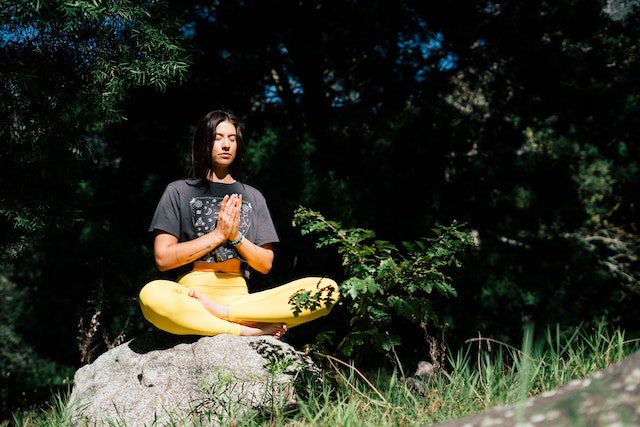As someone who’s interested in meditation, you’re probably already familiar with the concept. However, there are still many misconceptions about what meditation is and how it works. One common misconception is that meditation is just a fancy way of sitting still and doing nothing, or worse, a form of sleeping while sitting up. While it’s true that meditation often involves sitting or lying down in a quiet space, it’s much more than that. Meditation is a powerful tool that can help you train your mind, reduce stress, and improve your overall well-being. And, if you’re a beginner, there’s no need to be intimidated or overwhelmed. With the right guidance and a little bit of practice, anyone can learn to meditate and enjoy its benefits.
In this comprehensive guide, we’ll cover everything you need to know to start your own meditation practice.
What is Meditation?
Meditation is a powerful mental practice that involves training both your attention and awareness to achieve a calm, peaceful and relaxed state of mind. It’s a technique that can be used to improve mental and emotional health, increase your mental focus, and reduce your stress levels. There are many different forms of meditation, including walking meditation among others, but most involve focusing on a specific object or sensation, such as your breath, a sound, or a mantra. By paying attention to your breath or the sensations in your body, you can learn to quiet your mind and find a sense of inner peace.
Common Types of Meditative Practices.
While there are many different types of meditation practices, (see the list below), it’s important to remember that meditation is a personal journey and what works for one person may not work for another. So, if you’re new to meditation or have tried it before with little success, don’t get discouraged. With patience, dedication, and an open mind, you can find a meditation practice that works for you.
Here are a few that you can further research:
- Mindfulness meditation: Focus on present moment sensations without judgment.
- Transcendental Meditation (TM): Use a personal mantra to reach a state of deep relaxation and inner peace.
- Loving-kindness meditation: Cultivate feelings of compassion and kindness towards oneself and others.
- Chakra meditation: Use visualization and/or sound to balance and align the body’s energy centers.
- Vipassana meditation: Develop insight and awareness through the observation of bodily sensations and mental phenomena.
- Zen meditation: Focus on breathing and quieting the mind to cultivate a sense of inner peace and clarity.
- Yoga meditation: Use movement and breath to cultivate mindfulness and focus the mind.
- Body scan meditation: Bring awareness to each part of the body, releasing tension and promoting relaxation.
- Breath awareness meditation: Focus on the sensation of the breath to develop mindfulness and calm the mind.
- Mantra meditation: Repeat a word or phrase to quiet the mind and reach a state of deep relaxation.
Again, don’t let the list above worry you. Once you have begun your journey into meditation, you will undoubtedly grow and expand that journey as time goes on. You will want to learn advanced concepts an techniques that allow for your continued growth.
Benefits of Meditation
The entire point of meditation for most people is that there are benefits to continued practice of these principles. Those benefits are deeply personal to most, eye opening and will likely leave you wondering why you never took up meditation before. These benefits are deeply personal to most individuals and can have a profound impact on their lives. When you start meditating, you’ll likely find that your mind is more clear and focused, and you may feel more in control of your thoughts and emotions. You may also find that you’re better able to handle challenging situations and approach them with a calm and centered mindset.
There are many benefits to practicing meditation regularly, including:
- Reduced stress and anxiety
- Increased focus and concentration
- Improved sleep quality
- Lowered blood pressure
- Increased feelings of well-being and happiness
Once again, as you continue down the path of meditation practices, you will encounter additional benefits that could even seem “otherworldly” in nature. Imagine for a moment that oyu gain insight into your own life, nearly seeing your life play out before you encountered it. Imagine having a “peaceful mind” no matter what stress comes your way on a day to day basis. How much more relaxed would your life be if you already knew everything was going to work out just fine for you?
Meditation is often associated with the path of enlightenment because it allows one to gain a deeper understanding of the self and the world around them. Through the practice of meditation, one can cultivate mindfulness, wisdom, and compassion, which are all important qualities on the path to enlightenment. By quieting the mind and becoming more present in the moment, individuals can begin to see things more clearly and gain insight into their own nature. This can lead to greater awareness, acceptance, and ultimately, a deeper sense of peace and fulfillment.
How to Meditate
Now that you understand the basics of why you should incorporate meditation into your life, and some of its many benefits, let’s dive into the step-by-step process of how to meditate.
- Choose a quiet space – Find a quiet and comfortable place where you won’t be interrupted. This can be anywhere, from a spare bedroom to a local park.
- Helpful Tip: Place yourself in a peaceful environment, away from any or all distractions (if possible). This could be a quiet room with soft lighting or a quiet park with the sound of birds chirping, waterfalls, or near a lake.
- Get comfortable – Sit in a comfortable position, either on the floor or in a chair. Keep your back straight, and your hands resting on your knees or in your lap.
- Helpful Tip: Try to get yourself into a comfortable position with your back straight and your hands resting on your knees. Feel the ease and relaxation in your body. You should be comfortable but not looking to fall asleep.
- Set a timer – Decide on a length of time for your meditation session, anywhere from 5 to 30 minutes is a good place to start. Set a timer or use a meditation app to keep track of time.
- Download the Calm app today and take the first step towards a more peaceful mind – offers a variety of guided meditations and tools to support your mindfulness journey
- Focus on your breathing – Close your eyes and focus your attention on your breath. Notice the sensation of your breath as it flows in and out of your body.
- Visualization Tip: Close your eyes and take a deep breath in, feeling the cool air fill your lungs. As you exhale, imagine releasing all your tension and worries. Continue to focus on your breath, feeling each inhale and exhale.
- Stay focused – If your mind starts to wander, gently bring your attention back to your breath. Don’t worry if you find yourself getting distracted, this is normal and happens to everyone.
- Visualization Tip: If your mind starts to wander, imagine gently guiding your attention back to your breath. See yourself letting go of any thoughts or distractions and coming back to your breath with ease.
- End your meditation – When your timer goes off, slowly open your eyes and take a few deep breaths before getting up.
- Recovery Tip: you may be groggy after meditation. You might fall asleep during your meditation. You may be thirsty, have some water nearby. These things happen. It’s ok. Make note of how you feel the first few times you do this so that you may better prepare yourself the next time you meditate.
Once you have become familiar with the basics of meditation, there are many advanced techniques you can explore to deepen your practice. The Silva Method, for example, is a popular approach that combines meditation with visualization to help you achieve your goals and tap into your inner wisdom. Other advanced meditation techniques include Vipassana, Kundalini, and Taoist meditation, each of which offers unique benefits and can help you to unlock new levels of awareness and inner peace.
Researching and experimenting with these advanced techniques can help you to take your meditation practice to the next level and experience profound spiritual growth.
Tips for Beginners
Starting a meditation practice can be challenging, but with these tips, you’ll be on your way to a successful practice in no time.
- Start small – Begin with just a few minutes of meditation per day and gradually work your way up to longer sessions.
- Be consistent – Try to meditate at the same time each day to establish a routine.
- Use guided meditations – There are many free guided meditations available online that can help you get started.
- Don’t judge yourself – Meditation is a practice, not a performance. Don’t worry about getting it “right” or “wrong.”
Additional Steps to Consider
- Incorporate mindfulness into daily activities: Practice mindfulness while doing simple tasks such as brushing your teeth or washing dishes. This can help you to stay present and aware in the moment.
- Explore different meditation styles: There are many different types of meditation practices beyond those mentioned, such as sound meditation or walking meditation. Experimenting with different styles can help you to find what works best for you.
- Attend a meditation retreat: Going on a meditation retreat can be a powerful way to deepen your practice and connect with a community of like-minded individuals.
- Meditation retreat centers: Kripalu Center for Yoga & Health, Insight Meditation Society, and Esalen Institute
- Use guided meditations: Guided meditations can be a helpful tool for beginners and advanced practitioners alike, as they provide guidance and structure for your practice.
- YouTube channels for guided meditation: The Honest Guys, Headspace, and Tara Brach
- Journaling: Incorporating journaling into your meditation practice can help you to reflect on your experiences and gain deeper insights into your thoughts and emotions.
Additional Mediation Resources
- Meditation apps:
- Headspace: https://www.headspace.com/
- Calm: https://www.calm.com/
- Insight Timer: https://insighttimer.com/
- Books on meditation:
- “The Power of Now” by Eckhart Tolle: https://www.eckharttolle.com/books/newearth/
- “The Miracle of Mindfulness” by Thich Nhat Hanh: https://www.penguinrandomhouse.com/books/120039/the-miracle-of-mindfulness-by-thich-nhat-hanh/
- “10% Happier” by Dan Harris: https://www.10percenthappier.com/book/
In Conclusion
Congratulations on taking the first steps on your meditation journey! By now, you’ve learned about the many benefits of meditation and the different techniques you can use to deepen your practice. Whether you prefer to meditate alone or with the guidance of an app, book, or teacher, the key is to stay committed to your practice and keep an open mind as you explore new techniques and approaches.
Remember, meditation is not a destination, but a journey. As you continue to meditate regularly, you may notice changes in your mood, stress levels, relationships, and overall well-being. You may also discover new aspects of yourself and tap into your inner wisdom and intuition.
So keep practicing, stay curious, and be kind to yourself along the way. The benefits of meditation are not just for you, but for the world around you. As you cultivate inner peace, compassion, and clarity, you’ll be better equipped to make a positive impact in your life and in the lives of others. Wishing you all the best on your meditation journey!
Personal Note Regarding My Own Meditation Journey
Even as an adult, I have struggled with various forms of anxiety and stress. I would worry about the future, relationships, family and then dwell on the past, struggle to find peace in the present moment, and even stress myself into panic attacks. It wasn’t until I truly discovered the benefits of consistent meditation that I truly started to find some inner peace.
At first, it was difficult to quiet my mind and focus on my breath. I would get frustrated with myself when I couldn’t sit still for more than a few minutes. But over time, with consistent practice, I started to notice a difference in how I approached my daily life.
I often found myself less reactive to stressors and more able to stay centered in the present moment. I even started to experience moments of pure bliss and joy during my meditation practice. It was like a weight had been lifted off my shoulders.
Of course, it’s not always going to be easy, no one should ever tell you “meditation is simple”. There are always those days when my mind is racing and I can’t seem to find that inner peace I seek. Imagine how long it takes Buddhist Monks to partake of this journey and you will understand the true sense of time needed for mastery. But I knew that with continued practice and dedication, I would continue to grow and learn how to better control my own thoughts and emotions.
Meditation has truly been a transformative journey for me, and I encourage anyone who is looking to find more peace and happiness in their life to give it a try.




